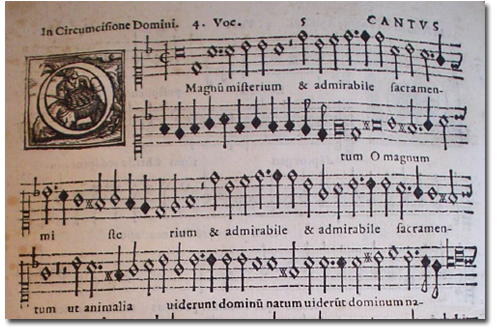Saturday morning quotes 6.25: Magnum mysterium 2
 Despite the profusion of disquieting world events and the looming unpleasantness of the U.S. presidential election, we return to the subject of our new recording of music for the Christmas season, Magnum Mysterium, which tends to serve as a calming antidote for world-weary angst and frazzled nerves—even for us. We began with last week’s post that included background and details of music by William Byrd. This week, we offer background and context for another of our four polyphonic settings of the Christmas responsory text, “O magnum mysterium”, the well-known and beloved favorite by Tomás Luis de Victoria (c. 1548 – 1611).
Despite the profusion of disquieting world events and the looming unpleasantness of the U.S. presidential election, we return to the subject of our new recording of music for the Christmas season, Magnum Mysterium, which tends to serve as a calming antidote for world-weary angst and frazzled nerves—even for us. We began with last week’s post that included background and details of music by William Byrd. This week, we offer background and context for another of our four polyphonic settings of the Christmas responsory text, “O magnum mysterium”, the well-known and beloved favorite by Tomás Luis de Victoria (c. 1548 – 1611).
As usual, things are not always what they seem on the surface, and received ideas and generalizations tend to unravel when subjected to a closer examination. For instance, while we typically refer to the composer as “Victoria”, his surname was actually “Luis”, and we should really refer to the composer as Tomás Luis from Victoria. The same goes for the famous lute composer, Francesco Canova da Milano. When we simply refer to him as “Milano”, we tend to negate the value of all the other notable musicians who happened to be associated with capital of the Lombardy region.
Tomás Luis de Victoria’s setting of “O magnum mysterium” was published in Thomæ Ludovici de Victoria abulensis. Motecta que partim. Quaternis. Partim, quinis, alia, senis, alia Octonis Vocibus Concinuntur. Venetijs Apud Filios Antonij Gardani. 1572. The collection included 33 motets and antiphons in four, five, and six voices, with a setting of Ave Maria in eight voices. The composer liked his setting of “O magnum mysterium” so well he used it as the model for a Mass setting, published in Liber secundus, 1592. The motet is justifiably well-known and is a staple in the Christmas holiday repertory of many choirs, professional and amateur. The organization of the piece is clear and succinct, with three discreet sections delineated by strong cadences.
For more detail, we quote from a description found in An Analysis of Performance Practice Trends in Recent Recordings of Tomás Luis De Victoria’s O Magnum Mysterium…as Related to Historical and Contemporary Scholarly Literature, a dissertation by Adam Gerhard Walter Luebke.
“The first section of the motet, as outlined by the text, describes the first mystery of the text through the words “jacentem in praesepio.” This A section is set in imitative polyphony and delineated by a strong perfect authentic cadence on G, the fourth scale degree. Marked by contrary motion expanding from a sixth on the penultimate chord to an octave on the final chord, the cantus approaches the final tone from a raised preparatory leading tone while the tenor steps down to the G. The bass drops a fifth to the G and the altus sings a raised third on the final chord.”
…
“The second section of the work celebrates the second mystery of the text: the Virgin
birth. The delineation between the A and B sections stems from the strong closing cadence of the A section and the contrast of all voice parts singing simultaneously in the B section. The parts continue in homorhythm until a brief moment of polyphony sets up this section‟s closing cadence, again on G. The mensuration remains the same as at the beginning.”“The third section, C, is an extended expression of the word Alleluia. The delineation between the B section and the C section also results from a strong authentic cadence that closes the B section. Additionally, Victoria changes the mensural sign to contrast the joyfulness of the word Alleluia with the solemnity of the motet’s preceding text. Here the breve is divided into three semibreves with the sign 3/2. Because scholars believe that Victoria oversaw the publication of this motet, they believe it is clear that he intends sesquialtera proportion, or three semibreves of the proportion in the space of two semibreves of the preceding section.”
“The ternary proportion, 3/2, reverts to the original mensuration, for the final flourish of the motet. Building up to the closing cadence Victoria returns the four voices to imitative polyphony elongating the word Alleluia through descending scales. The final cadence is a perfect authentic cadence on G approached by the raised leading tone in the cantus and against contrary motion down to the raised third and fifth in the altus and tenor. The bassus drops a fifth to G.”
– Luebke, pp. 64-65
While the rather technical language may pass over the heads of those who simply appreciate the music, a deeper understanding of the composer’s conceptual layout, artistic vision, and musical devices only adds to that appreciation. A detail that seems to be missing in descriptions of the piece is the significance of the repeated falling fifth, a device that appears throughout. The falling fifth in sacred music of the sixteenth century is typically symbolic of a genuflection, a fact that demonstrates the priest-composer’s intimate grasp of symbolism within the liturgy.

Tomás Luis de Victoria’s understanding of the liturgy is further elucidated by the inscription at the opening of “O magnum misterium”—while the text is proper to the Nativity, this setting of the motet was actually intended for the Feast of the Circumcision, a fact that is strengthened by the composer’s close supervision of the 1572 publication. Currently, the Feast of the Circumcision is renamed and observed on the 1st of January, the Octave Day of the Nativity of the Lord, the Solemnity of Mary, the Holy Mother of God, and also the commemoration of the conferral of the Most Holy Name of Jesus.
Even though the music is meant for a different feast day, Tomás Luis de Victoria’s setting of “O magnum mysterium” will remain an evocative reminder of the great mystery of Christmas. As with all the music on our recording, our performance is arranged for voice and lute, effectively highlighting the text with subtle interweaving of the three lower voices on the lute. Our recording, released November 1st, 2016, is available for streaming on Spotify, as mp3 downloads on Amazon, Bandcamp, and iTunes, and the CD is available directly from the artists, on its own or packaged with an edition of all the scores, notated for voice and lute with transcriptions of lute parts in keyboard notation.

Thank you so much for this wonderful recording. If Duo Seraphim is the least commercial Christmas album, Magnum Mysterium is the most essential one. “Coronata di stelle”, as Petrarch would put it. Crowned with stars, indeed.
LikeLike